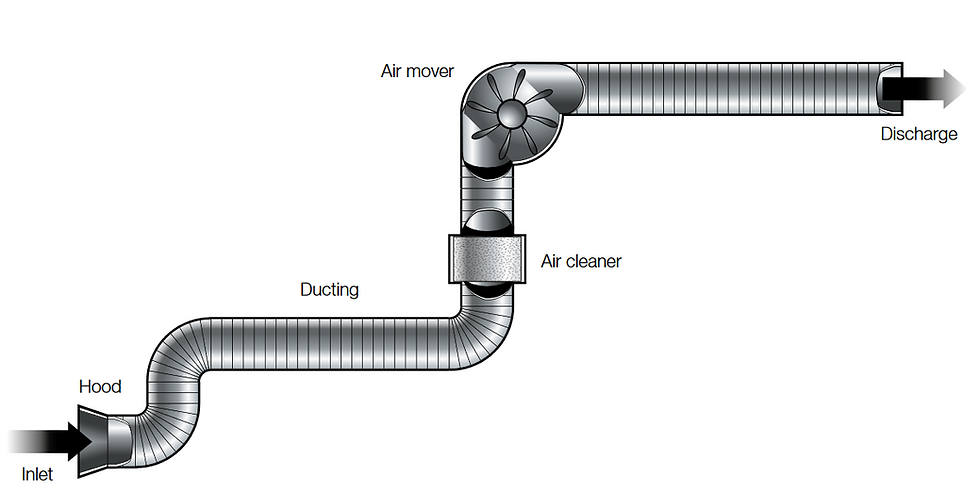What Is Local Exhaust Ventilation?
- RCS

- Mar 29, 2021
- 3 min read
Updated: Apr 7, 2021

In its simplest terms local exhaust ventilation is an engineering system to protect employees from exposure to hazardous substances by containing or capturing them locally, at the emission point.
Local exhaust ventilation (LEV) is only one of many engineering control options that may be used to remove and prevent employee exposure to vapour, mist, dust or other airborne contaminants. To be effective in protecting the employee(s), it is important that it is of good design, is fit for purpose, is regularly maintained and the system’s performance is monitored. Failure to do so can lead to employees being exposed because they have the impression that the system is effective when it is not.
Advantages of Correct LEV Use
Properly positioned LEV and/or well-designed units will capture emissions at source and so protect the employee from exposure.
The general supply air volume can be reduced as it is not relied upon to dilute contaminants.
The Main Elements of an LEV System
A hood of some kind, where the contaminants enter the system
Ducting, which safely transports the contaminants to a filter/cleaner/exhaust point
Air cleaner/filter/scrubber
Air mover: a fan to power the system
Discharge: a safe point of air exhaust

When using LEV to control exposure, the employer must thoroughly assess the hazards to be controlled and be satisfied that the LEV system is fit for purpose, used correctly by trained employees, regularly maintained to remain effective, and records are kept to demonstrate the system is both effective and ongoing.
Having a good understanding of what hazards need to be controlled is crucial to ensure that the initial design is capable of achieving adequate control.
Good design and fit for purpose
Good design and being fit for purpose are the crucial initial considerations to ensure the effectiveness of the system. Poor design and/or maintenance may lead, for example, to leakage in the workplace, causing concentrated local exposure rather than preventing it. A poorly designed, installed, misused and incorrectly maintained system can become an expensive waste of expenditure and may give a false impression of hazard control.
The unit in its entirety must be of good design. For example:
Leak-proof: leakage on the suction or negative pressure side of the air remover will lead to inefficient extraction. Leakage on the positive pressure side may reintroduce the contaminant back into the workplace.
The flow rate of air through the system must be sufficient to achieve the initial capture/ containment and carry all contaminants to the purifying/filtering system (transport velocity). Combustible dusts (wood dust, for example), if not extracted properly, can deposit in the ducting and be a fire or explosion risk. Flammable solvents being captured by the system need to be diluted by sufficient air flow to prevent the formation of a flammable mixture.
The ducting needs to be structured so as to avoid eddy currents and inefficient flow. For example, it should not have sharp right-angled turns, as this leads to dead areas with no flow.
The construction and materials of construction need to be compatible with the contaminants being extracted. For example, where flammable gases or vapours are being extracted, the system should not be able to generate a source of ignition. Likely ignition sources could arise from the use of non-rated electrical equipment such as the air mover, or from the accumulation of static electricity from the lack of earthing and bonding and the use of non-conductive materials. Corrosion by the contaminants is another consideration.
Where the process changes and additions or changes are needed the overall design should be reconsidered so the system remains effective. Creeping additions and extensions of the system can be a temptation for expediency, but lead to totally ineffective systems. If a system is redesigned, it also needs to be re-commissioned.
What Can RCS Do For You
RCS provide Local Exhaust Ventilation solutions for a vast array of industrial air filtration needs. These include hazardous, volatile and explosive dust and fume extraction needs.
We offer a range of services which encompass the entire spectrum of LEV requirements. Services can be purchased individually or as part of a Turn-key solutions package. Call us on +44(0)1563 546807 or click here to contact us for more information.




Comments